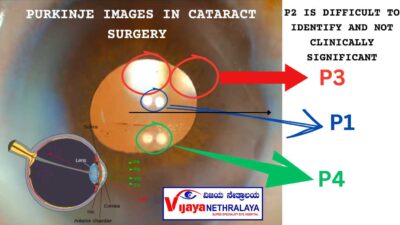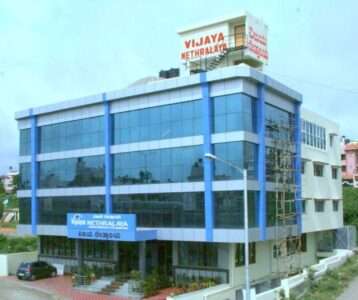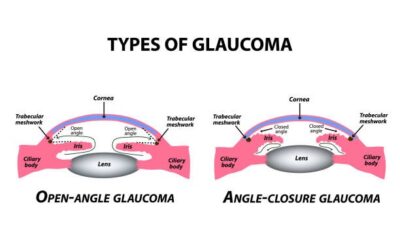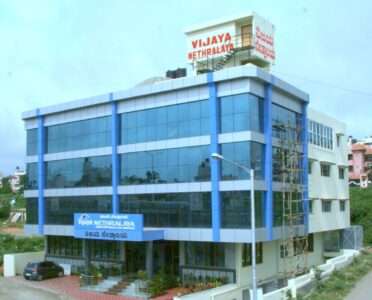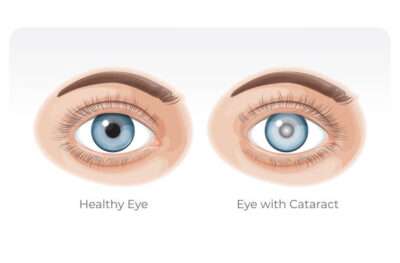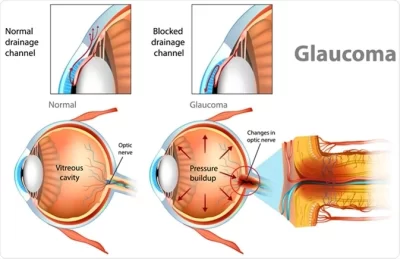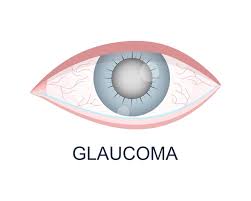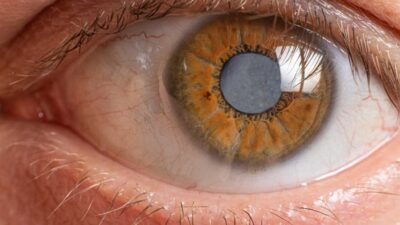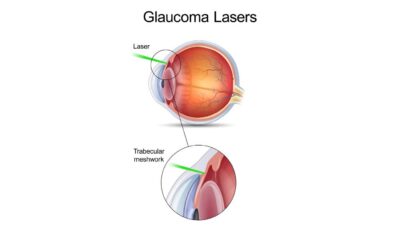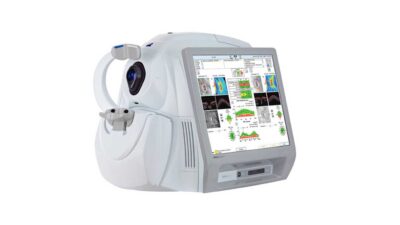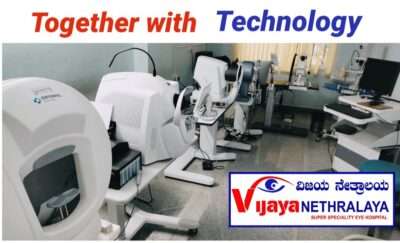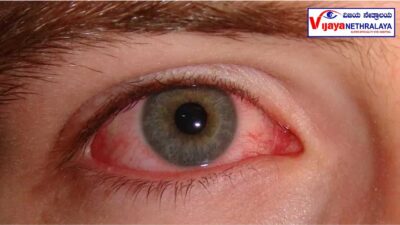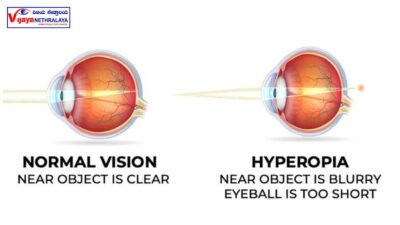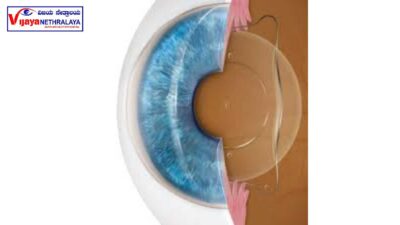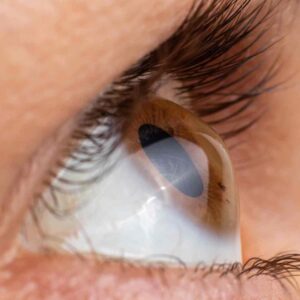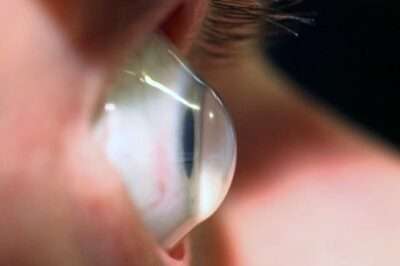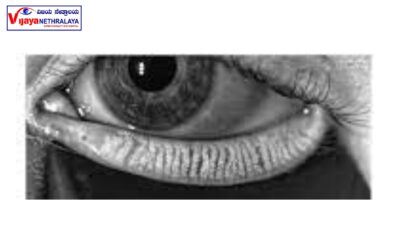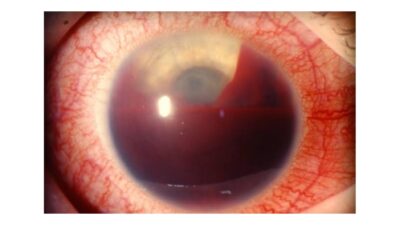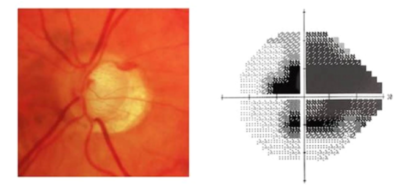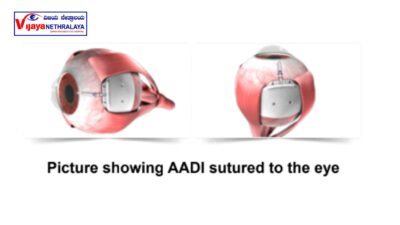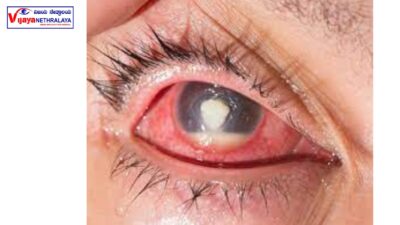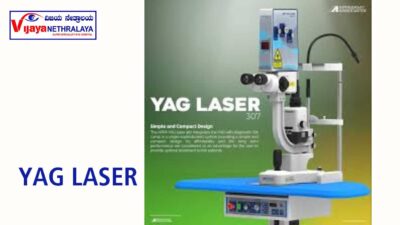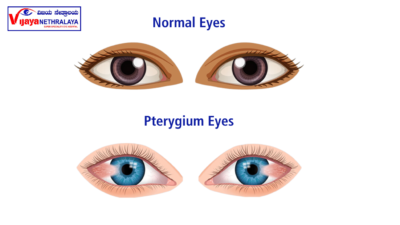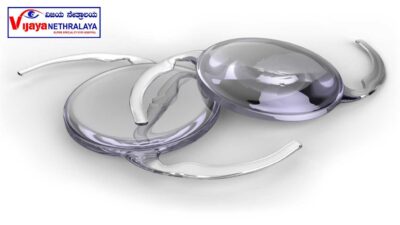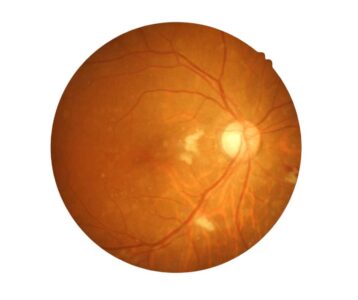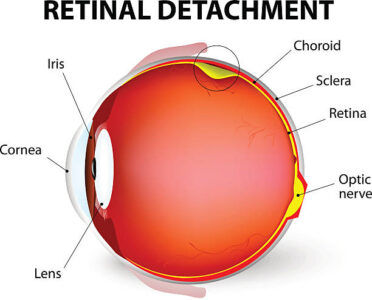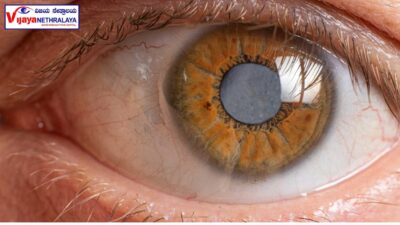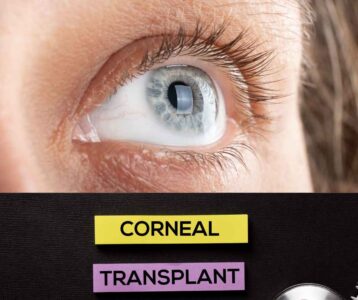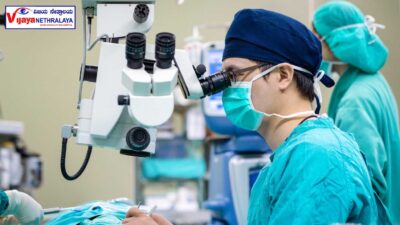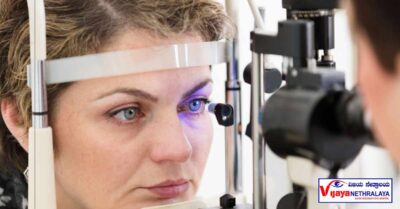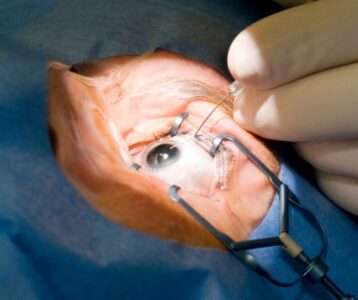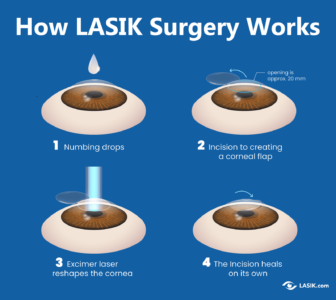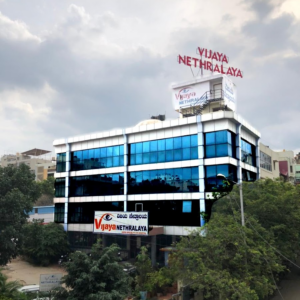Pneumatic Retinopexy
What is Pneumatic Retinopexy?
The retina is a layer of cells located at the back of the eye. Its function is to transform light into electrical impulses that are sent to the brain for processing. When the retina becomes detached from the back of the eye, you can lose all or part of your vision in the affected eye. If left untreated, retina detachment can cause permanent vision loss.
Pneumatic retinopexy (PR) is a surgical procedure that is used to reattach a detached retina and restore vision. This treatment involves injecting an expandable gas into the eye and then applying either retinal cryotherapy or laser photocoagulation to seal any retinal breaks.
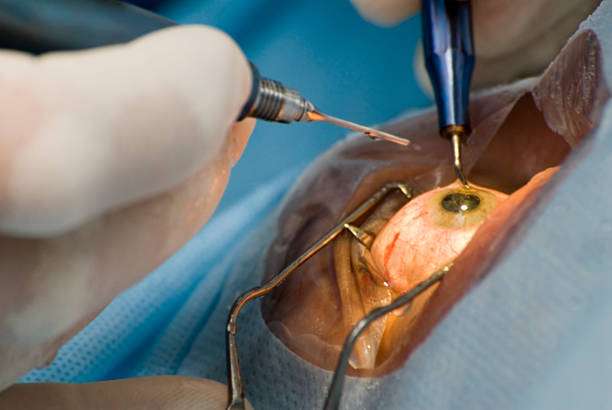
Who’s A Good Candidate for Pneumatic Retinopexy?
A pneumatic retinopexy may be recommended for patients who have:
- A single tear
- A tear located in the upper portion of the retina
- The ability to remain in the correct position for an extended period of time after surgery is critical for healing properly.
How Is a Pneumatic Retinopexy Performed?
Pneumatic retinopexy is a minimally invasive procedure used to treat a detached retina. First, your retina specialist will numb your eyes and dilate them with eye drops. Then, a small amount of gas will be injected into the vitreous to create a bubble. Next, your doctor will use an ophthalmoscope to look into your eye to position the bubble correctly. Finally, laser surgery or cryopexy will be performed to seal any retinal tears.
Are There Any Risks With Pneumatic Retinopexy?
The risks associated with retinal detachment surgery vary depending on a number of factors, including age, pre-existing medical conditions, and the specifics of the retinal detachment itself. The more common risks associated with this procedure are as follows:
- Persistent or recurrent detachment of your retina
- Trapped gas in your eye
- Inflammation in your eye
- Increase in your eye pressure (glaucoma)
- Bleeding in your eye
- New retinal tears
Recovery after Pneumatic Retinopexy
Here, the gas bubble needs to rest until a seal forms between the retina and the wall of the eye, which will help prevent retinal detachment. This means that the patients need to keep their head resting in the correct position for about 90% of the day, for 1 to 3 weeks after surgery so that the detachment can heal.
Pneumatic Retinopexy at Vijaya Netheralaya Eye Hospital in Bangalore
The Vijaya Nethralaya Super Specialty Eye Hospital has been a leading provider of eye care for 10 years. At our vitreoretinal clinic, We have a team of specialists with decades of experience treating retinal detachments and other disorders of the retina and vitreous. We are the leading experts in our field and can provide you with the best possible care for your condition. You can browse our online provider directory to learn more about our team, or call us to schedule an appointment. We're here for you and will provide the care you need. Whether you're looking for someone to talk to about your problems or you need help with day-to-day tasks, we're here for you. We'll do our best to provide you with the support you need so that you can get back to your happy & healthy life.
You Shouldn't Ignore Eye Problems
Now you can get the best treatment from our senior doctors at the most affordable prices by Booking an appointment.
Our Latest Posts
The Importance of Purkinje Images in Cataract Surgery:
- Featured
-
Posted by
Ambika Khuba
This Blog helps understand Purkinje images and Their significance in cataract Surgery. Please find the Video and Link-in-Bio
Can Squint Eye Be Corrected In Adults: Treatment Options & Risks
- Featured
-
Posted by
Ambika Khuba
Squint eye, also known as strabismus, is a condition characterized by misalignment of the eyes. While commonly associated with children, squint eye can also affect adults, causing discomfort and visual impairment.
Best Cataract Surgeon in Bangalore: Restoring Clear Vision with Expertise
- Featured
-
Posted by
Ambika Khuba
Imagine a world without clear vision – the vibrant colors, intricate details, and the simple pleasure of seeing loved ones’ faces. Fortunately, advancements in medical science have made it possible to combat visual impairments like cataracts. In the bustling city of Bangalore, individuals seeking to regain their sight are met with a plethora of options. Among these, finding the best cataract surgeon becomes paramount.
Pterygium Symptoms: Understanding, Prevention, and Treatment
- Featured
-
Posted by
Ambika Khuba
Pterygium is more than just a cosmetic concern; it can cause various discomforts and even affect vision if not managed properly. In this article, we will explore Pterygium symptoms, potential causes, and effective ways to prevent and treat it.
Eye Hospitals In Bangalore:
- Featured
-
Posted by
Ambika Khuba
In Bangalore, there are several well-known eye hospitals that offer a range of services for various eye conditions. Among these, one notable eye hospital is “Vijaya Nethralaya Eye Hospital,” located in Nagarbhavi. Importantly, this renowned hospital offers a wide array of services, covering different aspects of eye care.
Pediatric Ophthalmologist in Bangalore: Specialized Care for Children’s Eye Health
- Featured
-
Posted by
Ambika Khuba
When it comes to your child’s eye health, it’s crucial to seek specialized care from a pediatric ophthalmologist. In Bangalore, there are several renowned pediatric ophthalmologists who are dedicated to providing comprehensive eye care services exclusively for children. Moreover, these specialists have the expertise and experience to diagnose and treat various eye conditions in young patients. In this article, we will discuss the importance of pediatric ophthalmology and also highlight some of the top pediatric ophthalmologists in Bangalore.
Pterygium Causes: Understanding the Factors Behind this Eye Condition
- Featured
-
Posted by
Ambika Khuba
Pterygium, often referred to as “surfer’s eye,” is a benign growth that starts on the white part of the eye and may extend onto the cornea. While it’s typically not cancerous, it can cause discomfort, redness, and visual disturbances. To better understand how to prevent and manage pterygium, it’s important to explore the causes behind its development.
Cataract and Glaucoma: Understanding Two Common Eye Conditions
- Featured
-
Posted by
Ambika Khuba
Glaucoma Surgery Side Effects: What You Need to know
- Featured
-
Posted by
Ambika Khuba
Glaucoma surgery is performed to treat and manage the increased intraocular pressure that is characteristic of glaucoma. While these surgeries can be effective in controlling the disease and preventing further damage to the optic nerve, they also come with potential side effects. It’s important to note that not everyone will experience these side effects, and their severity can vary.
Bangalore Eye Hospital: Vijayanethralaya-—Providing Vision Care Excellence
- Featured
-
Posted by
Ambika Khuba
Vision is undeniably one of our most precious senses, and safeguarding its health and well-being becomes crucial for leading a fulfilling life.
Laser in Eye: Shedding Light on Ophthalmic Applications
- Featured
-
Posted by
Ambika Khuba
In recent years, laser eye surgery has emerged as a groundbreaking solution for individuals seeking to correct their vision. This revolutionary procedure has transformed the lives of millions, offering a safe and effective alternative to traditional eyeglasses or contact lenses. In this article, we will explore the incredible benefits of laser eye surgery, the different types available, and what to expect during the recovery process.
How is Cataract Surgery Done: A Comprehensive Guide
- Featured
-
Posted by
Ambika Khuba
This is a common medical procedure performed to treat cataracts, a clouding of the lens in the eye that can lead to vision impairment. This surgery has evolved significantly over the years, becoming a highly effective and safe method for restoring clear vision. In this article, we will delve into the details of how cataract surgery is performed, exploring the various techniques and steps involved.
Understanding Redness of the Eye: Causes, Symptoms, and Treatment Options
- Featured
-
Posted by
Ambika Khuba
Redness of the eye, also known as eye redness or bloodshot eyes, is a common condition that can occur due to various factors. The blood vessels in the white part of the eye become enlarged and more visible, resulting in a reddish appearance.In this article, we will explore the causes, symptoms, and treatment options for redness of the eye, helping you understand this condition and find relief.
Understanding the Complications of Glaucoma:
- Featured
-
Posted by
Ambika Khuba
Glaucoma is a serious eye condition that affects millions of people worldwide. While it’s often associated with elevated intraocular pressure (IOP), there’s more to this condition than meets the eye. In this article, we’ll delve into the complications of glaucoma, shedding light on its various aspects and exploring how it can impact a person’s vision and overall quality of life.
Cataract Prevention: Tips to for Bright Future Free from Cataracts
- Featured
-
Posted by
Ambika Khuba
Our eyes are precious organs that allow us to experience the world around us. However, as we age, certain eye conditions can impair our vision and quality of life. One such condition is cataracts, which affect millions of people worldwide. The good news is that there are several proactive steps we can take to prevent cataracts and maintain clear vision for years to come. In this blog, we will explore some effective strategies for cataract prevention.
Eye Hospital in Bangalore: Vijaya Nethralaya – Your Vision, Our Priority
- Featured
-
Posted by
Ambika Khuba
The Ultimate Guide to Choosing the Best Eye Hospital in Bangalore:
- Featured
-
Posted by
Ambika Khuba
When it comes to ensuring the health of our eyes, selecting the right eye hospital is of paramount importance. With numerous options available in Bangalore, finding the best eye hospital can be a challenging task.
Types of Congenital Glaucoma: Understanding Variants and Treatment Options
- Featured
-
Posted by
Ambika Khuba
If you’ve ever wondered about congenital glaucoma, you’re not alone. This rare but serious eye condition affects infants and young children, potentially leading to vision loss if left untreated. In this article, we’ll delve into the different types of congenital glaucoma, their distinct characteristics, and the available treatment options. So, let’s shed light on this condition that can impact a child’s visual future.
Glaucoma Symptoms: Recognizing Early Signs of Vision Trouble
- Featured
-
Posted by
Ambika Khuba
When it comes to maintaining our health, our eyes often take a back seat. However, vision problems can significantly impact our quality of life. One such condition that demands our attention is glaucoma. Glaucoma is a serious eye disease that can lead to irreversible vision loss if not detected and managed in its early stages. In this article, we will explore the various symptoms of glaucoma, helping you recognize the signs before they escalate.
Understanding Far Sightedness: A Comprehensive Guide
- Featured
-
Posted by
Ambika Khuba
In a world filled with screens and close-up tasks, it’s important to understand the concept of far-sightedness, or hyperopia. This eye condition impacts individuals differently, but with the right knowledge and care, one can effectively manage it. In this article, we’ll delve into the various aspects of far-sightedness, from its definition to its potential treatments. Whether you’re seeking information for yourself or a loved one, this guide aims to provide you with a clear understanding of far-sightedness.
Understanding Age-Related Farsightedness:
- Featured
-
Posted by
Ambika Khuba
Age-related farsightedness, commonly known as presbyopia, is a natural eye condition that affects individuals as they grow older. This article delves into the details of understanding age-related farsightedness, including its causes, symptoms, available treatments, and helpful tips for managing this visual challenge.
Motiyabind: Understanding causes, symptoms, and treatments
- Featured
-
Posted by
Ambika Khuba
Cataracts/ Motiyabind are clouding of the eye’s natural lens, leading to decreased vision. While primarily associated with aging, cataracts can develop for various reasons, impacting individuals of all ages. Understanding the causes, symptoms, and available treatments can empower you to make informed decisions about your eye health.
Is Glaucoma Curable: Understanding the Possibilities
- Featured
-
Posted by
Ambika Khuba
Glaucoma is a complex and serious eye condition that affects millions of people worldwide. It’s natural to wonder whether( is glaucoma curable) or no if there are treatment options available to manage the condition effectively.
Types of laser eye surgery for glaucoma:
- Featured
-
Posted by
Ambika Khuba
Glaucoma, a group of eye conditions that cause damage to the optic nerve, stands as a leading cause of irreversible blindness globally. However, the realm of medical advancements has ushered in a ray of hope with the introduction of various treatment options aimed at effectively managing glaucoma. In the following article, we will delve into the distinct types of laser eye surgery for glaucoma.
OCT Test for Glaucoma: Understanding Its Importance in Diagnosing and Managing the Condition
- Featured
-
Posted by
Ambika Khuba
In the realm of ophthalmology, the OCT (Optical Coherence Tomography) test has emerged as a revolutionary tool in the diagnosis and management of various eye conditions, including glaucoma. Leveraging its non-invasive and highly detailed imaging capabilities, the OCT test plays a crucial role in the early detection and monitoring of glaucoma, a serious eye disease that can lead to irreversible vision loss if not properly managed.
How Much Does LASIK Cost: A Comprehensive Guide:
- Featured
-
Posted by
Ambika Khuba
How much does LASIK cost? Well, the range begins at 17500 and extends up to 80000, in proximity to Vijayanethralaya Hospital.
Understanding Pink Eye: Causes, Symptoms, and Treatment
- Featured
-
Posted by
Ambika Khuba
Pink eye, also known as conjunctivitis, is the inflammation of the thin, transparent layer of tissue called conjunctiva that covers the white part of the eye.
Understanding Farsightedness: Causes, Symptoms, and Treatment Options
- Featured
-
Posted by
Ambika Khuba
When it comes to vision, clarity is of utmost importance. Farsightedness, also known as hyperopia, is a prevalent refractive error that affects how people perceive objects up close. In this article, we’ll delve into the causes, symptoms, and treatment options for farsightedness, shedding light on this eye condition that impacts millions of individuals worldwide.
Understanding Hyperopia: A Comprehensive Guide to Farsightedness
- Featured
-
Posted by
Ambika Khuba
Are you one of those people who find themselves struggling to read the fine print or deciphering messages on your smartphone up close? If so, you might be dealing with hyperopia, commonly known as farsightedness.
Vijaya Nethralaya Bangalore:
- Featured
-
Posted by
Ambika Khuba
Vijaya nethralaya bangalore is a renowned eye care hospital located in the heart of Bangalore, India. With a commitment to Superiority , Nethralaya has been serving the community for several decades. In this article, we will delve into the history, services, and achievements of nethralaya eye hospital bangalore, Discarding light on its contributions to eye care and overall well-being.
vijayanethralaya eye hospital: A Visionary Eye Care Institution:
- Featured
-
Posted by
Ambika Khuba
In a world where visual health is of utmost importance, Vijayanethralaya stands as a beacon of excellence in eye care. This esteemed eye care institution has been dedicated to preserving and restoring vision for millions of people since its inception. Combining cutting-edge technology, skilled ophthalmologists, and a patient-centric approach, Vijayanethralaya has become a leader in eye care services.
Implantable Contact Lens: A Vision Correction Innovation
- Featured
-
Posted by
Ambika Khuba
implantable contact lens – a revolutionary vision correction solution for refractive errors. Learn how they work, their benefits, and gain.
HOW TO AVOID ‘PINK EYES’ THIS MONSOON?
- Featured
-
Posted by
Ambika Khuba
Pink eye, also known as ‘CONJUNCTIVITIS’, is an inflammation of the conjunctiva, which is a transparent membrane that lines our eyeballs and eyelids. Conjunctivitis causes dilation of blood vessels in the conjunctiva, giving the appearance of Pink eye/Red eye, and is usually accompanied by increased watering and/or discharge from the eyes.
Understanding Cataract Laser Surgery:
- Featured
-
Posted by
Ambika Khuba
Cataracts, a common age-related eye condition, affect millions of people worldwide. Over time, the natural lens in the eye becomes clouded, leading to blurry vision and diminished eyesight. While traditional cataract surgery has been successful for many years, recent advancements in medical technology have given rise to cataract laser surgery, a more precise and innovative approach to restoring vision. In this article, we will explore the ins and outs of cataract laser surgery and how it has revolutionized cataract treatment.
Discover the Advantages of Permanent Contact Lens:
- Featured
-
Posted by
Ambika Khuba
If you are tired of constantly reaching for your glasses or dealing with the hassles of regular contact lenses, it might be time to consider a more permanent solution for your vision needs. Permanent contact lens, also known as orthokeratology lenses or overnight lenses, offer a revolutionary way to correct your vision and enjoy a life free from glasses. In this article, we will explore the advantages of permanent contact lenses and why they are gaining popularity among individuals with various vision problems.
Keratoconus Cure: Exploring Effective Treatment Options
- Featured
-
Posted by
Ambika Khuba
Keratoconus is a progressive eye disorder that affects the shape and clarity of the cornea, leading to distorted vision. Finding an effective cure for this condition is crucial for those affected by it. In this article, we will delve into various treatment options for keratoconus, focusing on the latest advancements and innovative approaches to manage this condition.
Discover the Best Fruits for Healthy Eyesight:
- Featured
-
Posted by
Ambika Khuba
When it comes to maintaining healthy eyesight, a balanced diet plays a crucial role. Among the many nutrients essential for eye health, certain fruits stand out as potent sources of vision-enhancing goodness. In this blog, we’ll delve ( Which fruit is good for eyes ) into the top five fruits that are excellent for your eyes. Incorporate these delicious and nutritious treats into your diet, and you’ll be supporting your eye health in the tastiest way possible!
Understanding Keratoconus Treatment Costs: Options and Considerations
- Featured
-
Posted by
Ambika Khuba
Keratoconus is an advanced eye condition that affects the shape and strength of the cornea, leading to control vision and potential vision loss if left unprocessed. While the cause of keratoconus remains unknown, several treatment options are available to manage the condition and improve visual acuity. However, the keratoconus treatment cost can be a significant concern for individuals seeking effective solutions.
Reversing Diabetes: A Comprehensive Guide to Taking Control of Your Eye Health
- Featured
-
Posted by
Ambika Khuba
, reversing diabetes for eye health is an achievable goal with dedication and the right approach. By managing blood sugar levels, adopting a healthy lifestyle, and seeking regular eye check-ups, individuals with diabetes can protect their precious gift of sight.
Best Fruits for Eyes: Nourish Your Vision Naturally
- Featured
-
Posted by
Ambika Khuba
Our eyes are incredible organs that allow us to see and experience the world around us. Consequently, it’s crucial to take care of our eye health to maintain clear vision and prevent potential eye problems as we age.
Cost of Cataract Operation: Understanding Prices and Factors
- Featured
-
Posted by
Ambika Khuba
Cataract surgery is a common and effective procedure for treating cataracts, a condition that clouds the lens of the eye, leading to blurred vision. The cost of cataract surgery in Bangalore can vary from one patient to another due to several factors.
Lasik Surgery Age Limit: What You Need to Know
- Featured
-
Posted by
Ambika Khuba
If you’re tired of relying on glasses or contact lenses to see clearly, LASIK surgery might be the solution you’ve been searching for. LASIK, which stands for Laser-Assisted In Situ Keratomileusis, is a popular and effective vision correction procedure that has helped millions of people worldwide achieve clearer vision without the need for corrective eyewear. However, before considering LASIK surgery, it’s essential to understand its age requirements and who can benefit from this life-changing procedure.
Squint Eye Surgery Cost in Bangalore: Finding Affordable Solutions for Clear Vision
- Featured
-
Posted by
Ambika Khuba
Squint eye surgery, also known as strabismus surgery, is a crucial medical procedure that aims to correct the misalignment of the eyes. This condition, commonly referred to as squint or strabismus, can cause discomfort, impact vision, and affect an individual’s appearance. In Bangalore, India, several medical centers offer squint eye surgery, each with its own cost structure and services. Let’s explore some of the affordable options available for this corrective procedure.
EPISCLERITIS: Understanding the Symptoms, Causes, and Treatment
- Featured
-
Posted by
Ambika Khuba
Episcleritis is a condition marked by redness of the episclera, which is a thin layer of tissue that covers the white part of the eye.
Understanding Diabetic Macular Edema: Causes, Symptoms, and Treatment Explained
- Featured
-
Posted by
Ambika Khuba
Diabetic macular edema (DME) is a condition that affects the eyes of individuals with diabetes. It occurs when fluid leaks into the macula, which is the central part of the retina responsible for sharp, central vision. As a result, the macula swells, leading to blurred or distorted vision.
Meibomian Gland Dysfunction (MGD): Causes, Symptoms, and Treatment
- Featured
-
Posted by
Ambika Khuba
Meibomian Gland Dysfunction (MGD) is a common eye condition that affects the meibomian glands, which are responsible for producing the oily layer of tears. Consequently, this condition can lead to various uncomfortable symptoms and potentially impact your overall eye health. In this article, we will delve into MGD in detail, examining its causes and symptoms, and exploring the available treatment options.
Understanding Traumatic Glaucoma:
- Featured
-
Posted by
Ambika Khuba
Traumatic glaucoma is a condition that arises as a result of blunt trauma to the eye. It is characterized by an increase in intraocular pressure (IOP), which can lead to damage to the optic nerve and permanent vision loss if left untreated.
Perimetry: Exploring the World of Visual Field Testing
- Featured
-
Posted by
Ambika Khuba
Perimetry is a crucial diagnostic tool used in the field of ophthalmology to evaluate a person’s visual field. It provides valuable insights into the sensitivity and extent of a person’s vision, helping detect and monitor various eye conditions. By measuring the ability to see objects in different parts of the visual field, perimetry aids in the early detection, diagnosis, and management of conditions such as glaucoma, retinal detachment, and optic nerve disorders.
The Ultimate Guide to AUROLAB AQUEOUS DRAINAGE IMPLANT (AADI): Managing Glaucoma Effectively
- Featured
-
Posted by
Ambika Khuba
At Vijaya Nethralaya, we are proud to present the Aurolab Aqueous Drainage Implant, a revolutionary breakthrough in glaucoma treatment. In this article, we will discuss the features, benefits, and efficacy of our innovative implant, highlighting its superiority over existing solutions in the market. If you are searching for an effective and reliable treatment option for glaucoma, look no further than the Aurolab Aqueous Drainage Implant.
Comprehensive Guide to Corneal Ulcer: Causes, Symptoms, and Treatment
- Featured
-
Posted by
Ambika Khuba
Welcome to our comprehensive guide on corneal ulcers. In this article, we aim to provide you with detailed information about corneal ulcers, including their causes, symptoms, and available treatment options. We, as a leading source of expert knowledge in the field, are dedicated to delivering accurate and helpful content to help you better understand and manage corneal ulcers.
Understanding YAG Laser PI:
- Featured
-
Posted by
Ambika Khuba
In the field of ophthalmology, innovative technologies have revolutionized various surgical procedures. One such advancement is the YAG Laser PI, a cutting-edge technique used for precise and safe eye surgery. This article aims to explore the intricacies of YAG Laser PI, its benefits, applications, procedure, and safety considerations.
Pterygium: Causes, Symptoms, and Treatment Options.
- Featured
-
Posted by
Ambika Khuba
A pterygium is a raised, yellowish, wing-shaped thickening on the white part of the eye, which can spread over the cornea, obstructing vision. The term Pterygium means wing-shaped. It is a degenerative wear and tear change of the surface of the eye, which results in growth of conjunctival tissue (from the white of the eye) across the cornea (the clear window through which we see). The pterygium is red, fleshy, and thickened in comparison with the normal conjunctiva.
Cataract Lens: Indian vs. Imported:
- Featured
-
Posted by
Ambika Khuba
Cataracts can significantly affect a person’s vision and quality of life. Thankfully, modern medical advancements offer a solution in the form of cataract surgery and the use of intraocular lenses (IOLs).
Living with a Macular Hole: A Personal Journey
- Featured
-
Posted by
Ambika Khuba
A macular hole refers to a small break or tear in the macula, which is the central part of the retina responsible for sharp and detailed vision. This condition often occurs due to age-related changes or trauma to the eye. Personally, experiencing a macular hole has given me firsthand knowledge of the physical and emotional toll it can take.
Corneal Cross-Linking (C3R): Advancing Vision Restoration with Collagen Cross-Linking:
- Featured
-
Posted by
Ambika Khuba
Understanding Diabetic Retinopathy: Early-Stage Symptoms and How to Detect Them
- Featured
-
Posted by
Priyanka Ghogge
Discover how to detect these symptoms and take proactive steps to protect your vision. Read our informative blog post now.
Diabetic Retinopathy: Recognizing the Symptoms
- Featured
-
Posted by
Ambika Khuba
Diabetic retinopathy is a serious eye condition that affects individuals with diabetes. It occurs when high blood sugar levels damage the blood vessels in the retina, leading to vision problems and potential blindness if left untreated.
Exploring the Different Types of Lenses Used in Cataract Surgery:
- Featured
-
Posted by
Ambika Khuba
Cataract surgery has evolved significantly over the years, and one of the key advancements lies in the various types of lenses used to replace the clouded natural lens. These lenses, also known as intraocular lenses (IOLs), play a crucial role in restoring vision and providing patients with enhanced visual capabilities.
Revisiting Clarity: A Second Chance for Cataract Surgery on the Same Eye
- Featured
-
Posted by
Ambika Khuba
Discover the potential of a second chance for cataract surgery on the same eye. Whether addressing complications, residual cataracts, or refractive errors, this opportunity offers renewed hope for restored vision. Consult with an experienced ophthalmologist to explore the possibilities and embark on a journey towards clearer sight.
Corneal Transplantation Restoring Sight with Advanced Surgical Techniques:
- Featured
-
Posted by
Ambika Khuba
Corneal transplantation, also known as corneal grafting, is a surgical procedure that aims to restore vision by replacing a damaged or diseased cornea with a healthy one from a donor. The cornea, a clear, dome-shaped tissue covering the front of the eye, plays a vital role in focusing incoming light onto the retina, allowing us to see clearly.
Eye Surgery Types: A Comprehensive Guide to Understanding Different Procedures
- Featured
-
Posted by
Ambika Khuba
Eye surgery encompasses a wide range of procedures that are performed to address various eye conditions and vision problems. These surgeries are designed to improve vision, correct refractive errors, treat eye diseases, or enhance the appearance of the eyes.
One of the most common types of eye surgery is LASIK (Laser-Assisted In Situ Keratomileusis), which is a refractive surgery aimed at correcting nearsightedness, farsightedness, and astigmatism. During LASIK, a precise laser is used to reshape the cornea, allowing light to properly focus on the retina and resulting in clearer vision. LASIK is known for its quick recovery time and high success rates, making it a popular choice for individuals seeking freedom from glasses or contact lenses.
Understanding Astigmatism: Causes, Symptoms, and Treatment Options
- Featured
-
Posted by
Ambika Khuba
Is Laser Eye Surgery Safe? Debunking the Myths and Revealing the Facts
- Featured
-
Posted by
Ambika Khuba
From Darkness to Light: How Cornea Transplants Restore Vision:
- Featured
-
Posted by
Ambika Khuba
The cornea is the clear, dome-shaped surface that covers the front of the eye and helps to focus light. When the cornea is damaged or diseased, it can cause vision problems or even blindness. In some cases, a corneal transplant may be necessary to restore vision.
How Laser Cataract Surgery Can Transform Cataract Patients Lives From Blurry to Bright
- Featured
-
Posted by
Ambika Khuba
Cataract laser surgery is a medical procedure that can dramatically transform the lives of cataract patients by restoring their vision from blurry to bright
Vitreoretinal Surgery: Improving Vision and Eye Health
- Featured
-
Posted by
Priyanka Ghogge
The vitreous is a substance that is similar to gel. It is located in the middle of your eye and fills the space.
Comprehensive Guide on the Cost and Procedure of PRK Surgery
- Featured
-
Posted by
Ambika Khuba
If you’re thinking of getting laser eye surgery, PRK is the right choice. Read this blog post to know what it’s all about.
Cataract Treatment Near Me: Everything You Need to Know
-
Posted by
Ambika Khuba
- 0 comments



